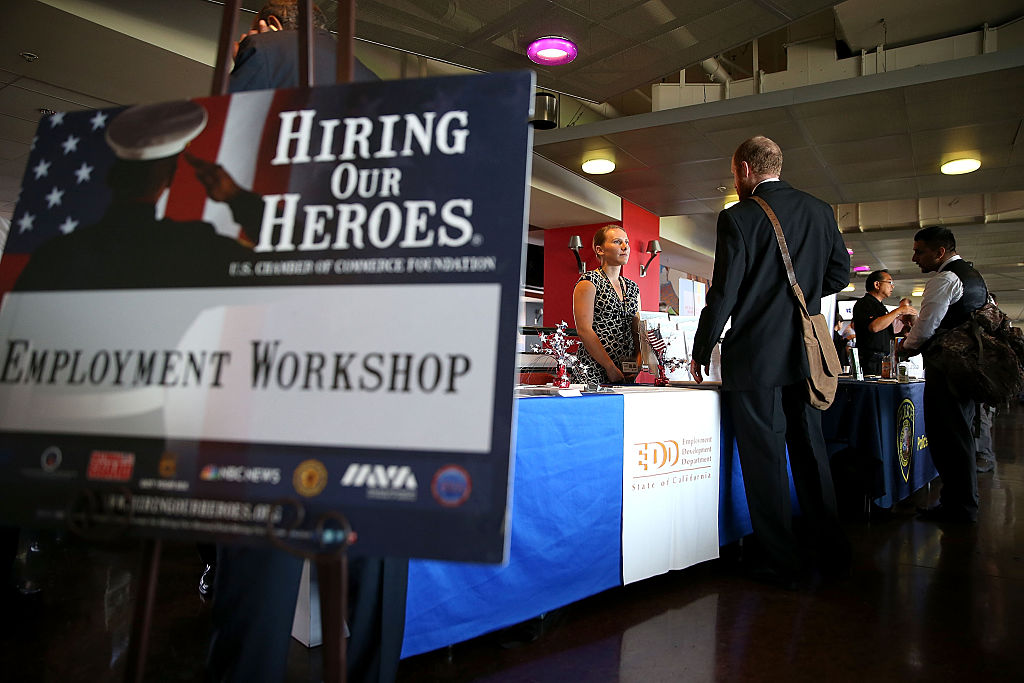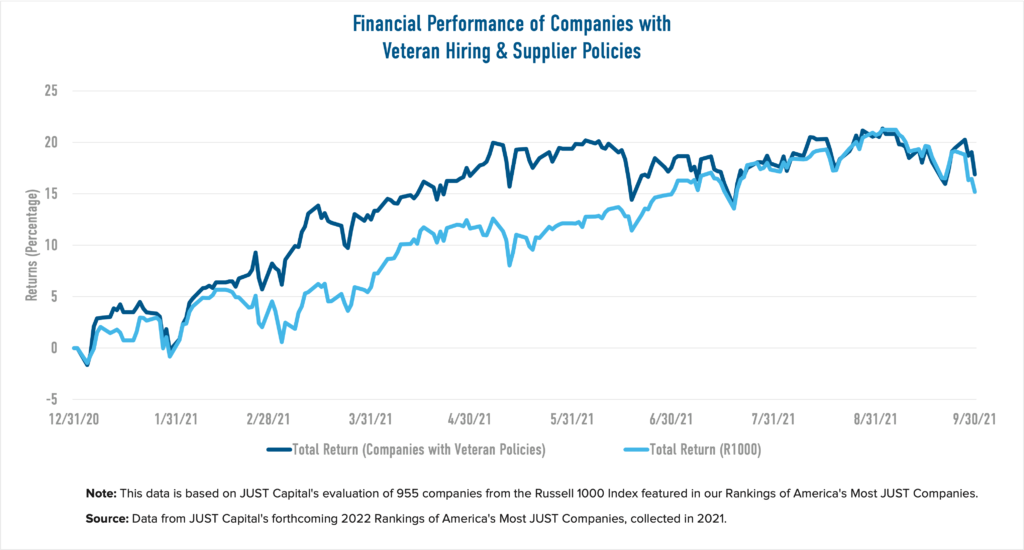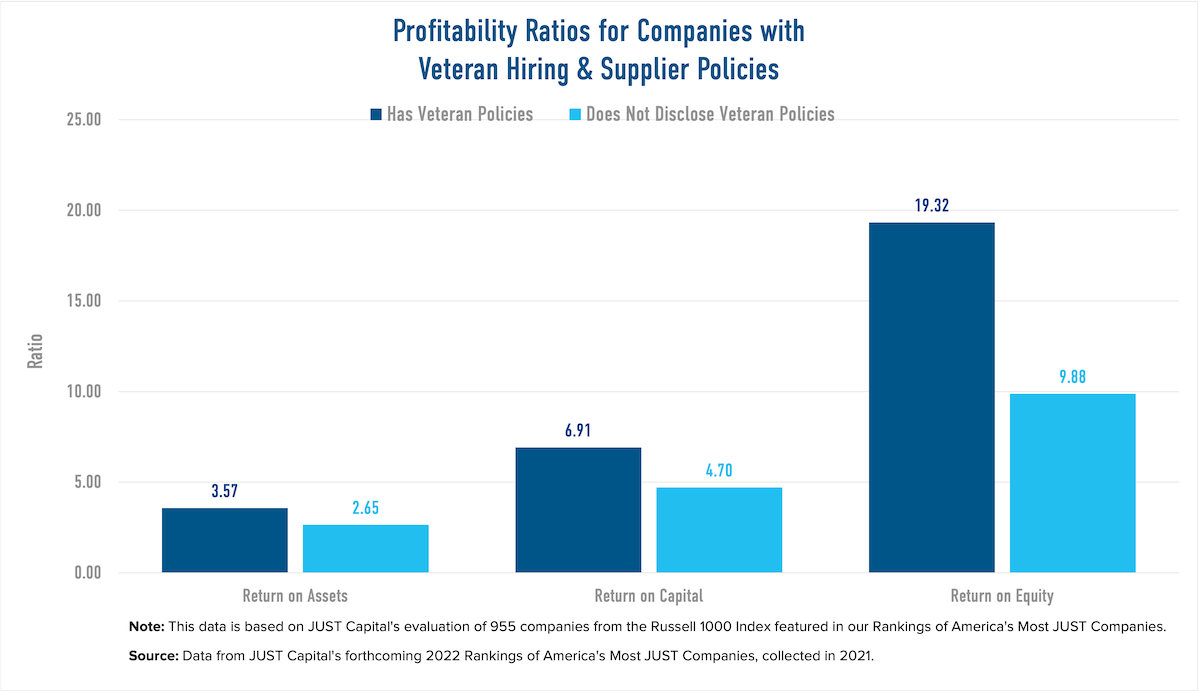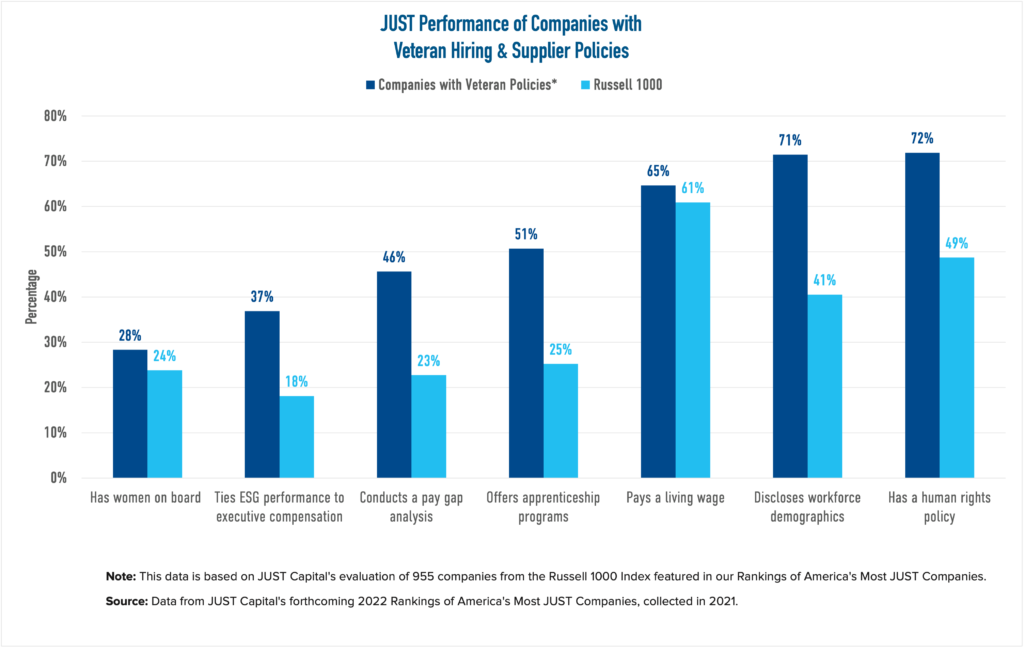JUST Report
Americans Want Companies to Do More for Veterans – Here Are Ways Businesses and Investors Are Showing What’s Possible
- More Reports
- View all JUST Reports

(Justin Sullivan/Getty Images)
Adrienne Wong, Mona Patni, and Daniel Krasner contributed to this report.
As Americans take time this week to honor our military service members for Veterans Day, the withdrawal of troops from America’s longest war and the 20th anniversary of 9/11 this past year have again brought the sacrifices of a whole generation of the military to the front of public consciousness.
Veterans have shouldered some of the most difficult challenges to American society of the last 20 years, from the wars in Afghanistan and Iraq to the effects of the Great Recession. And as fewer and fewer Americans experience military service firsthand, the civilian-military cultural divide continues to widen, placing even more importance on addressing challenges that veterans face in transitioning back to civilian life, like veteran underemployment – being employed in a lower-paying or part-time job despite having more advanced experience, skills, or credentials.
This holiday prompted us at JUST Capital to ask: What are America’s largest companies currently doing to support veterans? How can they strengthen their efforts to help those who have served? And what role can the investor community play?
We found that even though companies have used veterans initiatives to help build more inclusive workforces that drive better returns, and that these policies are popular with a large majority of Americans, nearly half of the country’s biggest corporations do not disclose specific veteran recruitment practices. Below, we’ve taken a closer look at the data and highlighted ways businesses are tapping into the unique skill sets veterans bring to work, and how investors are pushing for more progress.
The current state of corporate veteran policies
Our recent polling shows broad support for veterans and believe companies should do more as employers. We asked 3,058 people (including 352 enlisted or veterans) about what role corporations have in supporting veterans. And while 87% of respondents said they agreed that America’s largest companies have a responsibility to actively recruit veterans to their workforces, 57% said that most employers are not doing enough to help veteran workers.
Though 51% of respondents said that they would recommend the goods or services of a company that had recently announced a new veteran hiring initiative, these initiatives are not too common among the nation’s largest employers. Of the public disclosure data we collected from Russell 1000 companies for our 2022 Rankings, only 37% of them have a specific policy for actively recruiting veterans, distinct from employee resource groups or non-discrimination policies. Similarly, about 36% of these companies disclosed a veteran supplier policy, which are meant to increase supplier or contractor opportunities for the veteran-owned businesses that make up about 9% of all U.S. businesses. Roughly 23% of companies have both policies in place and 49% have neither. Looking at the collective data, it’s clear America’s largest companies have a long way to go to more comprehensively support veteran workers.

Corporate leaders that have developed ways to recruit and develop veterans
Advocates and experts say that, in general, veterans benefit from support in three main areas: healthcare, employment, and job training and education. While the federal government, through the Department of Veterans Affairs, provides healthcare and subsidized education, these services were historically denied from veterans of color. The private sector can play a role in providing meaningful employment opportunities and job training while potentially rectifying these exclusionary federal shortcomings. Recent research has found that while veterans tend to have higher rates of retention and promotions, 33% of veterans are underemployed, and are 15.6% more likely than non-veterans to be so.
Through ongoing tracking and analysis of corporate stakeholder performance, we have found a number of existing corporate programs and initiatives that help recent veterans find employment, build skills in a new trade of high demand, find flexibility in their new corporate roles, or find mentors who can help veterans navigate a new field.
In an effort to address barriers to employment and improve veteran hiring, just over 100 companies in our rankings are part of the Veteran Jobs Mission, a coalition of over 200 companies led by JPMorgan Chase pledging to have hired at least 100,000 veterans each by next year. Participants come from a range of industries, including consultancies like Accenture and Booz Allen Hamilton, food companies like Chipotle and Hershey’s, and utilities like Southern Company. To operationalize this type of program, it is critical for companies to have a well-versed human resources team or partner who understands the experience and skills of military candidates, as well as military resumes, and terminology. Inviting current veteran employees to sit on hiring panels can also help inform the process.
Underemployment is admittedly more challenging for companies to address. Veterans returning to civilian life may find it difficult to identify and land civilian jobs that closely match their military experience and training. For example, many veterans with combat training and infantry experience have trouble finding civilian occupations that can leverage that experience. Companies must recognize this mismatch of official credentials, education, or traditional work experience that often impacts veteran workers and, to overcome it, can offer aid in skills translation, re-licensing, and apprenticeships.
These opportunities should be easily available to veterans both before and after hiring. Microsoft, for instance, has partnered with other technology companies and the City of Los Angeles to create the Los Angeles Veterans Technology Training Academy (LAVTTA). This tech re-skilling program is open to all veteran residents of Los Angeles County, regardless of age or service status.
Companies can also participate in the Hiring Our Heroes program, which provides paid fellowship opportunities for transitioning veterans and their spouses to receive professional training and hands-on experience. Salesforce offers its own Hiring Our Heroes fellowship, which provides veterans and veteran spouses with 12-weeks of paid on-the-job training at a host company to become a certified Salesforce professional.
As the structure of war has changed, veterans face redeployment, creating gaps in their resumes and shifts in location. Employers may be prone to see these candidates as “risks,” “transient,” or “unstable,” and the spouses of veterans face similar obstacles. Companies can develop policies and resources available to veteran candidates and their spouses that allow for more flexible arrangements and are more forgiving, as Bank of America practices. This can also extend to worker benefits such as health services or paid-time-off for training, as interruptions due to military obligations may occur.
Another good model is provided by Amazon, which announced Project Juno, technology that enables military spouses that work at the company to organize a transfer of their job to a new location. Military families move as much as seven times more often than civilian families, so this HR tool can make a huge difference for military spouses and their career continuity.
Mentorship is also critical in helping veteran workers climb the career ladder. Employers should establish external and/or internal mentorship programs. One example of this is Veterati, a digital membership platform which provides mentorship opportunities to veterans, and is free to mentors and mentees. In a similar vein, while Employee Resource Groups are fairly common in large companies, holistic practices of laterally connecting veterans with their peers is key to bridging the growing civilian-military divide.
Investors are recognizing the benefits of veterans at businesses
It’s not just companies that can play an important part in addressing issues faced by veteran workers: The investor community, too, can help elevate these issues and channel capital to companies that best support veterans. Over the past few years, the market has seen a rise in specific Environmental, Social, and Governance (ESG) tied to ETFs, including investing in companies that hire and support veterans.
One example of the investor community’s efforts around veteran workers is the VETS Indexes. VETS Indexes provides two independent custom indices – VETSX and VTRNIX – composed of companies that do the most in hiring, retaining, and supporting veterans. The notion behind these indexes is that veterans bring unique skill sets, leadership, and a mission-critical mindset to the workplace, which subsequently allow for better management, more diversity in thinking, and contribute towards a firm’s overall performance. VETS Indexes develops their indices based largely on their survey of over 100 employers each year that evaluates a variety of topics from veteran development and retention to hiring and family support. Companies such as Bank of America, General Electric Company, General Motors Company, Home Depot, and Walmart make up some of the members of the indexes offered by VETS Indexes.
We conducted an analysis using our data to take a closer look at the financial performance of a larger group of companies with veteran hiring and supplier policies. Performance of an equally weighted basket of companies which have both veteran hiring and veteran supplier policies (218 companies in JUST universe meet that criteria, including 53 of the 54 companies that comprise VETS Indexes VTRNIX), as well as the performance of Russell 1000 index is shown below. This basket of companies slightly outperformed the market as measured by Russell 1000 over the year-to-date period (December 2020 to September 2021).

In addition to performance, we analyzed the profitability ratios for companies that have both policies versus those in the Russell 1000 with neither policy. Profitability ratios are financial metrics used by analysts and investors to measure and evaluate the ability of a company to generate income (profit) relative to revenue, balance sheet assets, operating costs, and shareholders’ equity. A higher ratio or value is commonly sought after by most companies, as this means the business is performing well by generating revenues, profits, and cash flow.
Based on data for the Return on Equity (ROE), Return on Assets (ROA), and Return on Capital (ROC) across the different cases, ROE is much higher for companies that have both veteran hiring and veteran supplier policies relative to those with no evidence of these policies, with a slightly higher ROA and ROC for that same comparison.

In addition to financial metrics, we measured the portfolio’s social impact across various JUST metrics, comparing the equally weighted basket of companies with both veteran hiring and supplier policies (VETS Basket) versus the Russell 1000 as shown below. This chart demonstrates that the VETS Basket not only has these two important veteran-focused policies but also is more likely to disclose workforce demographics, conduct a pay equity gap analysis, have a human rights policy, and offer an apprenticeship program. Based on this analysis, when investing in companies that back veterans, investors can feel good knowing that those companies are probably making headway in other important “S” in ESG, as well.

Corporate veteran policies can benefit all stakeholders
We’ve highlighted ways corporate leaders, investors, and even consumers can take steps to further support our military service members, especially those transitioning to civilian life. For corporate leaders, they can consider the challenges that their veteran coworkers and the veteran job applicants at their workplace might face, especially concerning underemployment. For investors who care deeply about veterans, there are options to consider through cause-specific ETFs. And for customers, they can choose to buy from companies that have a good track record as employers of veterans.
If companies, investors, and customers alike continue to further develop and operationalize these solutions, the labor market will no doubt become more equitable and inclusive, not just for veterans, but for everyone.